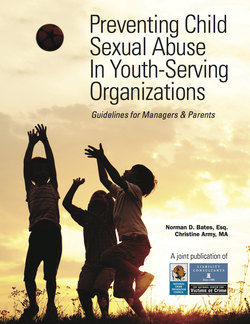Читать книгу Preventing Child Sexual Abuse In Youth-Serving Organizations - Norman D. Bates - Страница 3
На сайте Литреса книга снята с продажи.
Introduction
ОглавлениеChild sexual abuse (CSA) is an insidious crime that can destroy the lives of innocent children and leave their families devastated. The topic of child sexual abuse is, at best, a difficult subject to discuss and at worst, a horrifying one.
Why This Publication
The work of Liability Consultants, Inc. includes consulting with all types of organizations on their security problems and potential civil liability in the event that someone is a victim of a violent crime. That work has included retention in civil litigation involving rape and sexual abuse where a child was the victim. In the course of preparing for a number of cases, we found that there was a significant void in information pertaining to institutional response of child sexual abuse.
While there has been a great deal published on the subject of child sexual abuse, there is limited research data specific to extra-familial child sexual abuse within youth-serving organizations. There is also a lack of a single source for these organizations to reference in developing a program to help reduce the risk of such assaults. We also found that there was insufficient guidance for parents who may want to inquire as to how these organizations are protecting their children.
The objective of this publication is to provide information on the scope of the problem of child sexual abuse, offender and victim characteristics, and a model prevention program that includes pre-employment screening, supervision of staff, reporting abuse, and physical design controls available to organizations. We also hope to provide parents with resources and tools that will help them recognize, report, and be proactive against child abuse in youth organizations.
Clarifying the Terminology
This publication will use the term “child sexual abuse”, however, some terminology should be clarified. In many instances, the terms “child sexual abuse” and “child sexual assault” are used interchangeably. Yet the two terms have different legal meanings.
Child sexual abuse has been defined as the following:
“Child sexual abuse involves any sexual activity with a child where consent is not or cannot be given. This includes sexual contact that is accomplished by force or threat of force, regardless of the age of the participants, and all sexual contact between an adult and a child, regardless of whether there is deception or the child understands the sexual nature of the activity. Sexual contact between an older and a younger child also can be abusive if there is a significant disparity in age, development, or size, rendering the younger child incapable of giving informed consent. The sexually abusive acts may include sexual penetration, sexual touching, or non-contact sexual acts such as exposure or voyeurism.”1
Child sexual assault as defined by National Center for Victims of Crime is the following:
“Sexual assault takes many forms including attacks such as rape or attempted rape, as well as any unwanted sexual contact or threats. Usually a sexual assault occurs when someone touches any part of another person’s body in a sexual way, even through clothes, without that person’s consent.”2
These two terms most generally differ in that child sexual abuse encompasses a wider variety of acts that can include assault, the showing of pornography to a child, exposing oneself to a child, and voyeurism.
